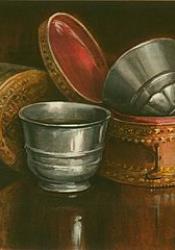Rise in Popularity of Antimony or Tartar Emetic
Although the chemical, antimony, is part of the periodic table as a metalloid that was grinded down to power and used in medicine and cosmetics since ancient Roman times, it wasn't until the nineteenth century that the popularity of it grew larger. Antimony was often compared to arsenic, which is also a chemical element and has similar properties. It's comeback was the result of antimony being banned for one hundred years in France, but antimonial cups continued to be sold and used until the late eighteenth century. During the period of the revival of medicine, which dates from 1500s to 1825, antimony was vastly used by chemists and physicians to find a universal remedy for a great number of diseases. Antimony found its way into almost every medicine chest during the victorian era in the form of tartar emetic. Small silver cups mentioned before, made of pure antimony, was used to store wine for twenty four hours. The reaction that occured from the wine and the chemical in the antimony produced an emetic effect when consumed, which was to induce vomiting, and made it very popular in medicine during this time period. The year 1825 brought on the acceptance of orally administered antimony under the influence of cultured Victorian physicians. Outside of the medical field, this compound inspired and aided in the crimes of people like George Chapman, who was a serial killer in England and poisoned his victims with antimony. Chapman was also suspected to be Jack the Ripper. This is also how Helen succeeded at deterring Arthur Jr. from wanting to drink alchol. By her adding a little bit of tartar emetic to his brandy or wine, it made him violently sick. By him associating being sick with drinking, he soon gave it up.
Works Cited
"Antimony." Wikipedia, Wikimedia Foundation, 23, November, 2020, en.wikipedia.org/wiki/Antimony
"Antimonial Cup." Wikipedia, Wikimedia Foundation, 4, November, 2020, en. wikipedia.org/wiki/Antimonial_cup
Hussey, Dr. Kristen. "May God Protect Us From such drugs and physicians! : A 17t Century Antimony Cup." Royal College of Physicians, 2018, history.rcplondon.ac.uk

